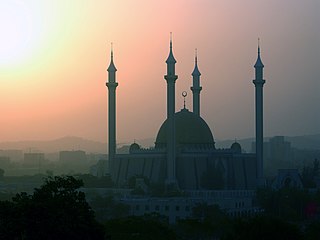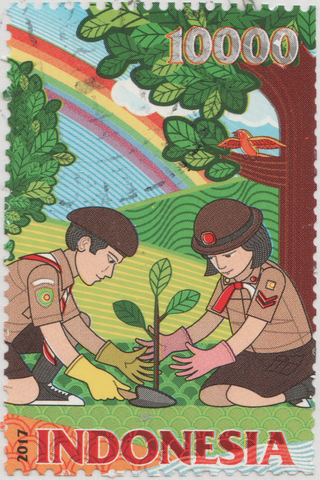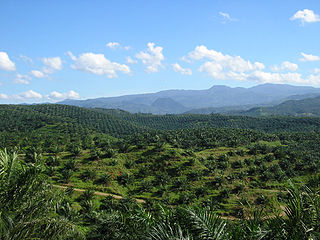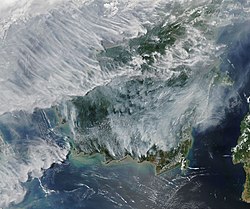
Smog, or smoke fog, is a type of intense air pollution. The word "smog" was coined in the early 20th century, and is a portmanteau of the words smoke and fog to refer to smoky fog due to its opacity, and odor. The word was then intended to refer to what was sometimes known as pea soup fog, a familiar and serious problem in London from the 19th century to the mid-20th century. This kind of visible air pollution is composed of nitrogen oxides, sulfur oxide, ozone, smoke and other particulates. Man-made smog is derived from coal combustion emissions, vehicular emissions, industrial emissions, forest and agricultural fires and photochemical reactions of these emissions.

Haze is traditionally an atmospheric phenomenon in which dust, smoke, and other dry particulates such as greenhouse gasses suspended in air obscure visibility and the clarity of the sky. The World Meteorological Organization manual of codes includes a classification of particulates causing horizontal obscuration into categories of fog, ice fog, steam fog, mist, haze, smoke, volcanic ash, dust, sand, and snow. Sources for particles that cause haze include farming, traffic, industry, windy weather, volcanic activity and wildfires. Seen from afar and depending on the direction of view with respect to the Sun, haze may appear brownish or bluish, while mist tends to be bluish grey instead. Whereas haze often is considered a phenomenon occurring in dry air, mist formation is a phenomenon in saturated, humid air. However, haze particles may act as condensation nuclei that leads to the subsequent vapor condensation and formation of mist droplets; such forms of haze are known as "wet haze".

The ASEAN Agreement on Transboundary Haze Pollution is a legally binding environmental agreement signed in 2002 by the member states of the Association of Southeast Asian Nations to reduce haze pollution in Southeast Asia. The Agreement recognises that transboundary haze pollution which results from land and/or forest fires should be mitigated through concerted national efforts and international co-operation.

Environmental issues in Indonesia are associated with the country's high population density and rapid industrialisation, and they are often given a lower priority due to high poverty levels, and an under-resourced governance.

The 2006 Southeast Asian haze was an air pollution event caused by continuous, uncontrolled burning from "slash and burn" cultivation in Indonesia, which affected several countries in the Southeast Asian region and beyond, including Malaysia, Singapore, southern Thailand, and as far away as Saipan; the effects of the haze may have even spread to South Korea. Local sources of industrial pollution also, inadvertently, contributed to increases in air toxicity ; notably at-risk areas included communities close to textile factories, fertilizer plants, meat-packing plants, industrialised dairy farms, shipping ports, and oil refineries. Air quality was lower, overall, for residents of more densely-populated cities. In the highly urban and industrialised Klang Valley of Malaysia, in particular, the surrounding elevated terrain acted as a natural retainer of polluted air, aggravating the situation as the haze set in.

The Pollutant Standards Index (PSI) is a type of air quality index, which is a number used to indicate the level of pollutants in air.

The Southeast Asian haze is a fire-related recurrent transboundary air pollution issue. Haze events, where air quality reaches hazardous levels due to high concentrations of airborne particulate matter from burning biomass, have caused adverse health, environmental and economic impacts in several countries in Southeast Asia. Caused primarily by slash-and-burn land clearing, the problem flares up every dry season to varying degrees and generally is worst between July and October and during El Niño events. Transboundary haze in Southeast Asia has been recorded since 1972 with the 1997 and 2015 events being particularly severe.

The 1997 group of forest fires in Indonesia that lasted well into 1998 were probably among the two or three, if not the largest, forest fires group in the last two centuries of recorded history.

The 2009 Southeast Asian haze was an episode of large scale air pollution primarily caused by slash and burn practices used to clear land for agricultural purposes in Sumatra, Indonesia. It affected the areas surrounding the Straits of Malacca which besides Indonesia include Malaysia and Singapore.

The environment of Malaysia is the biotas and geologies that constitute the natural environment of Malaysia. Malaysia's ecology is megadiverse, with a biodiverse range of flora and fauna found in various ecoregions throughout the country. Tropical rainforests encompass between 59% and 70% of Malaysia's total land area, of which 11.6% is pristine. Malaysia has the world's fifth largest mangrove area, which totals over a half a million hectares.

Air pollution has been an ongoing problem in many countries in the Southeast Asia region, and Malaysia is one of the worst affected. Haze has been a major issue for the country, driven by slash and burn practices by farmers and peat fires blown by the wind from Indonesia.

The 2005 Malaysian haze was an air pollution crisis caused primarily by fires in neighbouring Indonesia. In August 2005, haze spread across Malaysia from forest fires on the Indonesian island of Sumatra, leading to air quality reaching hazardous levels in certain states and the capital city, Kuala Lumpur. The Malaysian government declared states of emergency in affected regions, closed schools and held crisis talks with Indonesian officials. Farmers regularly burn scrub and forest to clear land during the dry season for agricultural purposes. The 2005 haze was at the time the worst to hit Malaysia since 1997.

Operation Haze is the biggest cross-border firefighting mission in history that involved teams of Malaysian firefighters going across to Indonesia to assist with putting out major fires that were causing severe haze across Southeast Asia.

The 2013 Southeast Asian haze was a haze crisis that affected several countries in Southeast Asia, including Brunei, Indonesia, Malaysia, Singapore and Southern Thailand, mainly during June and July 2013. The haze period was caused by large-scale burning in many parts of Sumatra and Borneo. Satellite imagery from NASA's Terra and Aqua satellites showed that the haze was mainly due to smoke from fires burning in Riau province, Indonesia.

Palm oil production is important to the economy of Indonesia as the country is the world's biggest producer and consumer of the commodity, providing about half of the world's supply. In 2016, Indonesia produced over 34.6 million metric tons of palm oil, and exported 25.1 million metric tons of it. Oil palm plantations stretch across 12 million hectares, and is projected to reach 13 million hectares by 2020. There are several different types of plantations, including small, privately owned plantations, and larger, state- owned plantations. There are a variety of health, environmental, and societal impacts that result from the production of palm oil in Indonesia. A recent publication by the NGO Rainforest Action Network (RAN) indicates that the use of palm oil by some of the biggest chocolate and snacks' producers is increasing this problem.

The 2015 Southeast Asian haze was an air pollution crisis affecting several countries in Southeast Asia, including Brunei, Indonesia, Malaysia, Singapore, southern Thailand, Vietnam, Cambodia and the Philippines.

The Transboundary Haze Pollution Act 2014 (THPA) is a statute of the Parliament of Singapore that criminalizes conduct which causes or contributes to haze pollution in Singapore, and to provide for related matters such as deterrence. The law is designed specifically to allow legal in suing companies for environmental pollution.

The 2016 Southeast Asian Haze was a transnational haze crisis which is a recurring problem with transboundary air pollution brought on by fires. The 2016 haze that took place affected several countries in Southeast Asia, including Indonesia, Malaysia and Singapore. It brought negative effects towards the environment and brought an impact on people's health and the economy.

The 2010 Southeast Asian haze was an air pollution crisis which affected many Southeast Asia countries such as Indonesia, Malaysia and Singapore during the month of October in 2010.

A trans-national air pollution crisis affected several countries in Southeast Asia from February to September 2019, including Brunei, Indonesia, Malaysia, the Philippines, Singapore, Thailand, and Vietnam.













